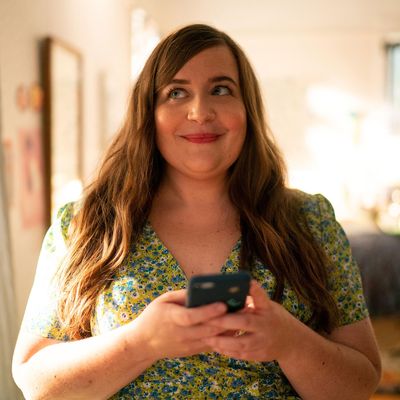
The last season of a television series usually brings some form of closure. The main characters find what they’re looking for, or seem to be on the right path, or at the very least are left in a place that feels like it belongs at the very end of a book.
The third and final season of Shrill doesn’t come with a sense of closure. That may be partly because, as noted in a recent Washington Post piece, co-creator and star Aidy Bryant originally had hoped Shrill would run for four seasons. But closure also isn’t really in keeping with Shrill’s sensibility.
As adapted from the book of the same name by Lindy West, who co-created the Hulu series with Bryant and Alexandra Rushfield, Shrill has always been about the evolution of its main character, Annie Easton (Bryant), a boundary-pushing writer for The Thorn, a Portland alt-weekly, whose romantic relationships are never quite worthy of her. In the final eight episodes, which drop today, Annie is still struggling in her professional and personal lives. But instead of making her someone with whom the audience should always unequivocally empathize, the writers take greater pains this season to highlight Annie’s blind spots and foibles. It’s an insightful and enjoyably low-key send-off for a show whose low-key vibe is one of its greatest assets.
One issue that Annie continues to deal with is her size, or rather, the way other people react to her size. In the first episode, an OB/GYN, subbing in for Annie’s usual doctor, casually recommends that Annie should consider bariatric surgery to reduce her weight. After the appointment, Annie spots the gynecologist across the parking lot and goes off on her — “You’re a bad person! You’re a bad fucking person!” — but the doctor doesn’t hear. She takes out her AirPods and waves a friendly hello, still content in the assumption that she’s done nothing wrong.
It’s a cathartic and funny incident that segues into something more thought-provoking in the following episode, when Annie writes a scathing column about the doctor. The woman responds by implementing a “Health at Every Size” approach in her practice and, also, asking The Thorn to take Annie’s article offline, which her editor Gabe (John Cameron Mitchell) rightly says is against the paper’s policy. While this lands on first viewing like a real “stick it to the clueless female gyno” moment, after watching all the episodes, the scene reveals itself as the first minor hint that Annie’s own agenda can crowd out her journalistic ethics and sense of empathy, something that will really come back to bite her later in the season.
That whole medical mini-narrative is precisely the kind of thing people mention when they call Shrill a show about body issues. That’s not a completely inaccurate description, but it also reduces Shrill to just a show about what it’s like to be fat. And it isn’t that. It’s a show about a fat woman whose weight is only one aspect of her life. The fact that the conflict with the OG/GYN winds up serving as the first strand in a braid of story lines about Annie’s insecurities, stubbornness, prejudgment of others, including romantic partners, and lack of storytelling perspective speaks to how holistically Shrill views its protagonist. Fatness is not the defining characteristic of most overweight people. The same thing can be said of Annie and Shrill.
Shrill is also not only about Annie. Her best friend and roommate Fran (Lolly Adefope) is nearly as much of a focal point this season, as her romance with girlfriend Emily (E.R. Fightmaster) becomes more serious and the cultural differences between them rise to the forefront. Annie and Fran operate on parallel tracks, each plunging into daunting territory at work and in their love lives as they inch closer toward feeling like full-fledged adults. Bryant and Adefope have a lived-in ease with each other that conveys how long their friendship has endured, even before an extended flashback in episode seven hammers home that point.
Both actors calibrate their performances to home in on the honesty in every scene. While their behavior may go to extremes, especially Annie’s, their acting never does. This is true of most of the cast, including Gabe, the self-involved Gen-Xer who thinks his rebel-punk days can never be outdone. Mitchell grounds his narcissism in believability, while still serving line deliveries that never cease to make me cackle. (When Annie is name-checked on a 29 Under 29 list, his response: “I was on a Five Under Five list when I was a lot smaller.”)
Shrill’s subtlety may have led overtaxed binge-watchers to pass it by in favor of shows about more attention-grabbing things like murder or fish-out-of-water soccer coaches or anything affiliated with Marvel or Star Wars. But it’s the sharp attention to life’s everyday calamities and how regular people learn to navigate them that has always made this series such a pleasure to watch. That’s what will be missed, especially as a lot of upcoming TV starts to lean more toward grand spectacle than small but meaningful insight. The good news is that, if you’ve been missing out on Shrill, there’s still time to experience it, which is actually the ultimate message of Shrill. If there’s no closure at the end of this final season, that’s because for Annie, Fran, and most people, life doesn’t just suddenly resolve itself. It and we, hopefully, keep evolving and doing the work to earn second chances.


